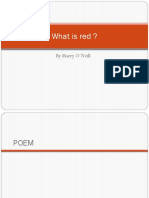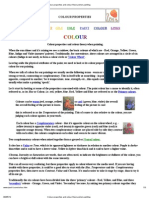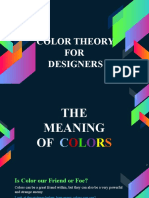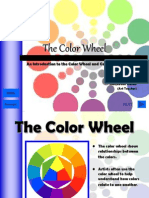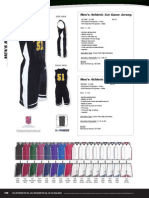0 ratings0% found this document useful (0 votes)
87 viewsWords and Expressions For Specifi C Colours
Words and Expressions For Specifi C Colours
Uploaded by
RafaelHidalgoSanchísThis document provides information about colors and color terminology in three sections:
1. Specific color words like jet black, shocking pink, ginger, and turquoise that are used to describe hair, fabrics, and the sea but not usually eyes. Gemstone names like ruby, emerald and amber are also used as color adjectives.
2. Terms for describing colors like primary, pastel, strong, harsh, and vivid colors. Fluorescent colors seem to glow in the dark. Monochrome uses only one color or shades of it.
3. Color metaphors where blue means depression, red means anger, danger or importance, green means nausea or envy, black means depressing or illegality, and grey
Copyright:
© All Rights Reserved
Available Formats
Download as PDF, TXT or read online from Scribd
Words and Expressions For Specifi C Colours
Words and Expressions For Specifi C Colours
Uploaded by
RafaelHidalgoSanchís0 ratings0% found this document useful (0 votes)
87 views1 pageThis document provides information about colors and color terminology in three sections:
1. Specific color words like jet black, shocking pink, ginger, and turquoise that are used to describe hair, fabrics, and the sea but not usually eyes. Gemstone names like ruby, emerald and amber are also used as color adjectives.
2. Terms for describing colors like primary, pastel, strong, harsh, and vivid colors. Fluorescent colors seem to glow in the dark. Monochrome uses only one color or shades of it.
3. Color metaphors where blue means depression, red means anger, danger or importance, green means nausea or envy, black means depressing or illegality, and grey
Original Description:
inglas
Original Title
EVU_Adv_u64
Copyright
© © All Rights Reserved
Available Formats
PDF, TXT or read online from Scribd
Share this document
Did you find this document useful?
Is this content inappropriate?
This document provides information about colors and color terminology in three sections:
1. Specific color words like jet black, shocking pink, ginger, and turquoise that are used to describe hair, fabrics, and the sea but not usually eyes. Gemstone names like ruby, emerald and amber are also used as color adjectives.
2. Terms for describing colors like primary, pastel, strong, harsh, and vivid colors. Fluorescent colors seem to glow in the dark. Monochrome uses only one color or shades of it.
3. Color metaphors where blue means depression, red means anger, danger or importance, green means nausea or envy, black means depressing or illegality, and grey
Copyright:
© All Rights Reserved
Available Formats
Download as PDF, TXT or read online from Scribd
Download as pdf or txt
0 ratings0% found this document useful (0 votes)
87 views1 pageWords and Expressions For Specifi C Colours
Words and Expressions For Specifi C Colours
Uploaded by
RafaelHidalgoSanchísThis document provides information about colors and color terminology in three sections:
1. Specific color words like jet black, shocking pink, ginger, and turquoise that are used to describe hair, fabrics, and the sea but not usually eyes. Gemstone names like ruby, emerald and amber are also used as color adjectives.
2. Terms for describing colors like primary, pastel, strong, harsh, and vivid colors. Fluorescent colors seem to glow in the dark. Monochrome uses only one color or shades of it.
3. Color metaphors where blue means depression, red means anger, danger or importance, green means nausea or envy, black means depressing or illegality, and grey
Copyright:
© All Rights Reserved
Available Formats
Download as PDF, TXT or read online from Scribd
Download as pdf or txt
You are on page 1of 1
64 All the colours of the rainbow
A Words and expressions for specific colours
pitch black: intensely black, used about darkness, night,
etc. (pitch is an old word for tar)
jet black: intensely black, used about hair, eyes, etc. (jet
is a black semi-precious gemstone)
scarlet: very bright red
crimson: strong deep red
shocking pink: an extremely bright pink
ginger: orangey red, used about hair and cats
navy: dark blue, used about clothes, not eyes
turquoise: greenish blue, used about fabrics, paint, sea,
etc. but not usually eyes
lime: a bright yellowish green
beige: a light creamy brown
mousy: a light not very interesting brown, used only about hair
chestnut: a deep reddish brown, used about hair and horses
auburn: a red-brown colour, usually used about hair
A number of words for gemstones are also used as colour adjectives, e.g. ruby [deep red],
emerald [bright green], amber [yellowy orange], coral [orangey pink], sapphire [deep blue],
jade[dark green].
B Words for talking about colour
Red, blue and yellow are primary colours; by mixing them together you can make other
colours. Pastel colours are pale shades of colour pink, mauve [pale purple] and pale yellow,
for example. Strong colours are the opposite of pastels. Harsh colours are colours that
are unpleasantly strong. Vivid colours are strong, bright colours like scarlet or turquoise.
Fluorescent colours are very bright colours which seem to glow in the dark. Electric blues or
greens are extremely bright blues or greens. If white has a tinge of green, there is a very slight
shade of green in it. If something is monochrome, it uses only one (or shades of one) colour,
e.g. black, white and grey. The suffixes -y and -ish show that a colour is partly present, e.g.
bluey green, reddish brown.
C Colour metaphors
blue = depression (to feel blue); physical or unskilled (blue-collar workers)
red = anger (to see red = to be very angry); danger (red alert, a red flag); special importance
(All the competitors were given the red-carpet treatment. The day we met will always be a
red-letter day for me.); communist or very left-wing in politics (Peoples views sometimes
become less red as they get older.)
green = nausea (to look green) (People who are seasick often turn/go green and sometimes
vomit.); envy (She turned green with envy when she saw her friends new car.); care for the
environment (green tourism; the Green Party)
black = depressing or without hope (a black future); anger (to look as black as thunder);
illegality or incorrectness (black market, black sheep of the family, black mark) (During the
war people bought many goods illegally on the black market. If I dont finish this report in
time, thatll be another black mark against my name. My brother was the black sheep of the
family, leaving school and home at the earliest opportunity.)
grey = lack of clarity (a grey area); brains (grey matter, grey cells)
white = purity (white as snow, whiter than white); being pale (She was so shocked that
she went white as a sheet.); a white-knuckle [terrifying] ride at an amusement park such as
Disneyland; office workers (white-collar workers)
134 English Vocabulary in Use Advanced
You might also like
- A Color Wheel Consisting of Primary - ZahraDocument12 pagesA Color Wheel Consisting of Primary - Zahrazahrabncdxb100% (1)
- Color Mixing GuideDocument88 pagesColor Mixing GuideJohn Johnson100% (5)
- 3 Primary ColorsDocument41 pages3 Primary ColorsArnab SenNo ratings yet
- Language Help: Useful Adjectives For Describing Works and PerformancesDocument1 pageLanguage Help: Useful Adjectives For Describing Works and PerformancesRafaelHidalgoSanchísNo ratings yet
- 1000SR 07 - Can - MK6Document11 pages1000SR 07 - Can - MK6marceloaav1100% (2)
- RGB Color Hex Cheat Sheet v1Document1 pageRGB Color Hex Cheat Sheet v1Sneetsher Crispy100% (4)
- Faber-Castell Polychromos Blank Color ChartDocument2 pagesFaber-Castell Polychromos Blank Color Chartjinteki.network100% (1)
- Pantone ChartDocument19 pagesPantone ChartCarlos Navarrete-PatinoNo ratings yet
- Color Business EtiqutteDocument8 pagesColor Business Etiqutteprasadpatil717466No ratings yet
- Color Theory Hand-OutsDocument5 pagesColor Theory Hand-OutsMJ TimoganNo ratings yet
- Associated With A CharacterDocument3 pagesAssociated With A CharacterEulysses EdquilagNo ratings yet
- Colours Used in ThrillersDocument4 pagesColours Used in Thrillersmohit_j932839No ratings yet
- Colour Symbolism: Effect of Colour in ArchitectureDocument50 pagesColour Symbolism: Effect of Colour in Architecturejumana hasin100% (1)
- Color MeaningDocument5 pagesColor MeaningaaqaaNo ratings yet
- Color Theory PDFDocument41 pagesColor Theory PDFJashid Pk100% (1)
- Color TheoryDocument13 pagesColor TheoryphauljeorgesNo ratings yet
- Color Theories For Graphics DesignerDocument10 pagesColor Theories For Graphics DesignerFeranmi OlayiwolaNo ratings yet
- Colours PDFDocument92 pagesColours PDFMridul DhingraNo ratings yet
- The Color WheelDocument8 pagesThe Color WheelAhnNo ratings yet
- Art AppreciationDocument36 pagesArt AppreciationPaulo Bollosa100% (1)
- The Meaning of ColorsDocument10 pagesThe Meaning of ColorsceltiftNo ratings yet
- Dathanna As GaeilgeDocument12 pagesDathanna As GaeilgeshinnylitesNo ratings yet
- Colour IdiomsDocument4 pagesColour IdiomsАннаNo ratings yet
- EOD Color - MeaningDocument8 pagesEOD Color - Meaningapi-3819350No ratings yet
- ColorsDocument41 pagesColorsTianboyNo ratings yet
- ReddDocument3 pagesReddAna Carmela CeballosNo ratings yet
- Colours Used in ThrillersDocument4 pagesColours Used in Thrillersmohit_j932839No ratings yet
- Fa 348 5. Hafta ColorDocument3 pagesFa 348 5. Hafta ColorAyse İnceNo ratings yet
- Color Assignment DesignDocument6 pagesColor Assignment DesignkassahunNo ratings yet
- Mixing Colors: Water, Oil Paints or Printing InksDocument88 pagesMixing Colors: Water, Oil Paints or Printing InksArquitecto Angeles100% (1)
- Chapter 7 - ColorDocument36 pagesChapter 7 - Colorروان البلوشيNo ratings yet
- Renwick Magazine FinalDocument2 pagesRenwick Magazine Finalapi-243432119No ratings yet
- What Is Red ?: by Marry O'NeillDocument21 pagesWhat Is Red ?: by Marry O'NeillAnonymous FAy7usZZNo ratings yet
- Colour Properties and Colour Theory When PaintingDocument3 pagesColour Properties and Colour Theory When PaintingAmalia CandiaNo ratings yet
- The Color WheelDocument33 pagesThe Color Wheeldet100% (1)
- CT 3Document78 pagesCT 3Jemimah FVNo ratings yet
- Color Wheel Powerpoint3333Document49 pagesColor Wheel Powerpoint3333Jannice Coscolluela Canlas100% (1)
- Ebook Mini Cold Deep Winter PDFDocument15 pagesEbook Mini Cold Deep Winter PDFSetsuka Sakurazuka100% (2)
- The Emotional Content of ColorsDocument5 pagesThe Emotional Content of Colorsapi-127153729100% (1)
- PTT Colour ChartDocument2 pagesPTT Colour ChartT GodNo ratings yet
- WHAT IS RED - MeaningsDocument7 pagesWHAT IS RED - MeaningsAin SyaqilahNo ratings yet
- Color Theory On FashionDocument37 pagesColor Theory On FashionMuhammad Hassan. Muhammad Hassan.No ratings yet
- ColoursDocument4 pagesColoursbabaNo ratings yet
- ColourDocument20 pagesColourKhushboo PriyaNo ratings yet
- (Std-9th) COLOUR THEORY-1Document19 pages(Std-9th) COLOUR THEORY-1Shivam PansareNo ratings yet
- Color TheoryDocument57 pagesColor Theorylieumarg87% (15)
- The Meaning of ColorsDocument4 pagesThe Meaning of ColorsNikko ManioNo ratings yet
- 2 ColoursDocument3 pages2 ColoursoscarmorgadoNo ratings yet
- Red. A Primary Color, This Color Is The "Hottest" One Out of The Warm Colors Group, andDocument6 pagesRed. A Primary Color, This Color Is The "Hottest" One Out of The Warm Colors Group, andMelissa LyonsNo ratings yet
- Colours IntroductionDocument121 pagesColours IntroductionDeepak KumarNo ratings yet
- AdjectivesDocument3 pagesAdjectivesjensantos0410No ratings yet
- Color Theory FinalDocument17 pagesColor Theory FinalMoh'd Kalis KapinaNo ratings yet
- Paint with Intention - Hoffmann, JoanDocument44 pagesPaint with Intention - Hoffmann, Joanerikadance35No ratings yet
- Lecture2 - Meaning of ColorsDocument44 pagesLecture2 - Meaning of ColorsMatia TianNo ratings yet
- Color Wheel PowerpointDocument49 pagesColor Wheel PowerpointEbb Tenebroso JudillaNo ratings yet
- Fashion B: Standard 08.0101.09 Elements of Color: By: Kris Caldwell Timpanogos High SchoolDocument26 pagesFashion B: Standard 08.0101.09 Elements of Color: By: Kris Caldwell Timpanogos High SchoolChetna Shetty Dikkar100% (1)
- Japanese Traditional ColorsDocument5 pagesJapanese Traditional ColorsСергей Преловский100% (1)
- Color Wheel PowerpointDocument46 pagesColor Wheel Powerpointcrazyleo74100% (2)
- Session - COLORDocument34 pagesSession - COLORPari JayaramanNo ratings yet
- Colours in JapaneseDocument1 pageColours in JapaneseferminkorndNo ratings yet
- Color TheoryDocument7 pagesColor TheoryMaria Marie100% (1)
- Colors: The Psychology and Theories of ColorsDocument45 pagesColors: The Psychology and Theories of ColorsDiana Sophia KanNo ratings yet
- Color TheoryDocument11 pagesColor TheorySamara Paiva83% (23)
- Swirling Designs Coloring Book: 18 Fun Designs + See How Colors Play Together + Creative IdeasFrom EverandSwirling Designs Coloring Book: 18 Fun Designs + See How Colors Play Together + Creative IdeasRating: 5 out of 5 stars5/5 (2)
- Code VeronicaDocument3 pagesCode VeronicaRafaelHidalgoSanchísNo ratings yet
- United Nations: Ethnic, Religious, Oppressed)Document1 pageUnited Nations: Ethnic, Religious, Oppressed)RafaelHidalgoSanchísNo ratings yet
- Cholesterol and Health: Cholesterol-Rich, But, If Eaten in Moderation, Do Not Significantly Raise Cholesterol LevelsDocument1 pageCholesterol and Health: Cholesterol-Rich, But, If Eaten in Moderation, Do Not Significantly Raise Cholesterol LevelsRafaelHidalgoSanchísNo ratings yet
- GMP29.ebook Minecraft Vol20 PDFDocument132 pagesGMP29.ebook Minecraft Vol20 PDFRafaelHidalgoSanchís100% (12)
- War and Violence: DiplomacyDocument1 pageWar and Violence: DiplomacyRafaelHidalgoSanchísNo ratings yet
- Describing Festivals: Noun Verb AdjectiveDocument1 pageDescribing Festivals: Noun Verb AdjectiveRafaelHidalgoSanchísNo ratings yet
- EVU Adv U37Document1 pageEVU Adv U37RafaelHidalgoSanchísNo ratings yet
- Verb + PrepositionDocument1 pageVerb + PrepositionRafaelHidalgoSanchísNo ratings yet
- Language Help: Describing Animals and BirdsDocument1 pageLanguage Help: Describing Animals and BirdsRafaelHidalgoSanchísNo ratings yet
- EVU Adv U26Document1 pageEVU Adv U26RafaelHidalgoSanchísNo ratings yet
- Carl's Career in Sales: TelemarketingDocument1 pageCarl's Career in Sales: TelemarketingRafaelHidalgoSanchísNo ratings yet
- Friendship: Quality OppositeDocument1 pageFriendship: Quality OppositeRafaelHidalgoSanchísNo ratings yet
- Grammar For FCEDocument8 pagesGrammar For FCERafaelHidalgoSanchísNo ratings yet
- Russell Basketball UniformsDocument17 pagesRussell Basketball Uniformsapi-165878767No ratings yet
- Dwarf Painting TutorialDocument6 pagesDwarf Painting TutorialTSEvansNo ratings yet
- Kavio! 2014 CatalogDocument226 pagesKavio! 2014 CatalogMike100% (1)
- Colors of The Rainbow: Click Here To BeginDocument24 pagesColors of The Rainbow: Click Here To Beginintan febriantiNo ratings yet
- Vizio M658-G1 CNET Review Calibration ResultsDocument3 pagesVizio M658-G1 CNET Review Calibration ResultsDavid KatzmaierNo ratings yet
- Meses Del Año Months of The YearDocument2 pagesMeses Del Año Months of The YearKelly CarrasquillaNo ratings yet
- Excel PricelistDocument19 pagesExcel Pricelistaogp93No ratings yet
- Color ValuesDocument10 pagesColor ValuesrsnaveenbaalajiNo ratings yet
- Pinout Pe1 - 63Document8 pagesPinout Pe1 - 63morozco1965No ratings yet
- Super7 - Magazine - SECRETBASE ChecklistDocument7 pagesSuper7 - Magazine - SECRETBASE ChecklistgungagelungaNo ratings yet
- Sorted by Color NameDocument8 pagesSorted by Color NameIrfan UllahNo ratings yet
- TFT ProgramDocument5 pagesTFT ProgramPuneeth KumarNo ratings yet
- Clown Cross Stitch Pattern (Color Detail)Document4 pagesClown Cross Stitch Pattern (Color Detail)isabella.ruiz8740No ratings yet
- Edaran Dirjen PDD Forlap-Sister 2019Document38 pagesEdaran Dirjen PDD Forlap-Sister 2019dwi50% (2)
- Rightway Catalogue Vol 2 2014-15Document62 pagesRightway Catalogue Vol 2 2014-15umprintingNo ratings yet
- DMC Cross Stitch PatternDocument18 pagesDMC Cross Stitch PatternRizza Q. PamintuanNo ratings yet
- Stock Check Form - October 2019: No Description Qty M L XL 2XlDocument28 pagesStock Check Form - October 2019: No Description Qty M L XL 2Xlspecies09No ratings yet
- Bs Colour Fan Bs 381c & Bs 4800Document5 pagesBs Colour Fan Bs 381c & Bs 4800Lee TuckerNo ratings yet
- Wissmach Glass Color Code Chart and Product ListDocument16 pagesWissmach Glass Color Code Chart and Product Listrhye999100% (1)
- Keya Catalogue 2012Document19 pagesKeya Catalogue 2012Vitor CostaNo ratings yet
- Colours PPTDocument30 pagesColours PPTMirela Cojocaru StetcoNo ratings yet
- Peter, Peter Pumpkin Eater by Ella Dolbear LeeDocument15 pagesPeter, Peter Pumpkin Eater by Ella Dolbear LeekhanNo ratings yet
- Sony XBR-65X950G CNET Calibration ResultsDocument3 pagesSony XBR-65X950G CNET Calibration ResultsDavid Katzmaier0% (1)
- Twiglet With Egyptian Large Cat Floss PDFDocument50 pagesTwiglet With Egyptian Large Cat Floss PDFglorygloNo ratings yet
- Pantone Solid To Process ValuesDocument25 pagesPantone Solid To Process Valuesmecano20% (1)
- Colors List - Carry OverDocument8 pagesColors List - Carry OverMỹ Hạnh TrầnNo ratings yet
































